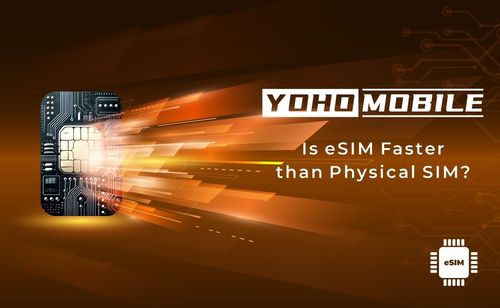The evolution of technology has changed how we connect and communicate, moving from physical SIM cards to the modern eSIM. This shift raises many questions, including whether eSIMs are faster than traditional SIM cards.
In this article, we’ll explore both technologies, compare their speeds and signal strengths, and help you decide which one is better for you.

eSIM and Physical SIM Cards
- Physical SIM: A physical SIM card is a small, removable chip inside most modern cellular phones. They store the information your phone needs to communicate and also contain your phone’s number and allow you to make calls, send texts, and access the internet.
- eSIM: Short for “embedded SIM”, is a tiny chip built directly within a device like a smartphone, tablet, or smartwatch. The main difference is that an eSIM is fixed to the device’s circuit board while a traditional SIM card can be stuck in and out. It holds subscriber information and connects your device to networks, without needing a physical SIM card.
Both types of SIMs authenticate your identity on the network, giving you access to voice, text, and data services. The shift to eSIM technology is a major advancement in mobile networks and connectivity. eSIMs let you manage multiple network profiles on one device without needing to swap physical SIM cards.
You Might Also Like:
- What Is An eSIM Card And How Do They Work?
- What is an eSIM for iPhone?
- How Many eSIMs Can You Add to Your Phone?
Signal Strength Differences: eSIM and Physical SIM
Signal strength refers to the power level of the radio signal received by your device from the cell tower. It is usually measured in dBm (decibels milliwatts). A stronger signal strength generally means better connection quality and fewer dropped calls. However, signal strength alone does not guarantee high data speeds.
While eSIMs offer advantages in terms of reliability and ease of switching between carriers, the overall signal strength is more heavily influenced by external factors rather than the type of SIM used. When comparing signal strength between eSIM and physical SIM, several factors should be considered:
Carrier and Network Infrastructure
- Carrier Coverage: The signal strength is mainly influenced by the carrier’s network coverage in a specific area. Both eSIMs and physical SIMs depend on the same network infrastructure provided by the carrier.
- Network Technology: 4G, 5G, and other network technologies will affect the signal strength and quality for both types of SIMs.
Device and Antenna Design
- Device Hardware: The design and quality of the device’s antenna can impact signal strength. This applies to both eSIM and physical SIM users.
- Integration: eSIMs, being embedded into the device, might experience slightly better reliability due to fewer physical connections that can fail or degrade over time.
Environmental Factors
- Location: Signal strength can vary depending on whether you are indoors, outdoors, in a rural area, or a city.
- Obstructions: Physical barriers like buildings, trees, and even weather conditions can affect signal strength.
Potential Differences Between eSIM and Physical SIM
- eSIM Reliability: eSIMs eliminate the physical SIM tray, reducing the chance of mechanical failures. This can lead to more consistent performance.
- Signal Strength Perception: Anecdotal reports suggest that eSIMs might have slightly weaker signal strength compared to physical SIMs, but this is generally marginal and not always noticeable in everyday use.
Speed Comparison: eSIM vs. Physical SIM
Network speed, often measured in Mbps (megabits per second), indicates how quickly data can be downloaded or uploaded. It reflects the data transfer rate of the network connection. Hence, higher network speeds result in faster downloads, uploads, and smoother streaming.
If you’re comparing network speeds, eSIMs and physical SIMs typically offer similar performance under identical conditions. Key factors influencing data speeds include:
- Network Infrastructure: The quality and extent of your carrier’s network coverage are significant determinants of internet speed. Advanced infrastructure and widespread coverage typically offer better speeds.
- Device Compatibility: Modern devices often support eSIM technology and are optimized for improved performance. These devices may handle data more efficiently, resulting in better speed experiences.
- Environmental Conditions: Physical barriers such as buildings, weather conditions, and geographic location can impact signal strength and data speeds. For example, urban areas with dense buildings may experience more signal interference.
- Network Congestion: High user traffic, especially during peak hours, can slow down internet speeds. Network congestion occurs when many users access the network simultaneously, leading to reduced data speeds for all.
The Advantages of eSIM
- Easy Carrier Switching: Switch carriers directly from your device without needing to replace a physical SIM card. Ideal for frequent travelers and those changing networks often.
- Space Efficiency: Embedded in the device, freeing up space for other components and allowing for slimmer designs.
- Enhanced Security: Less prone to physical damage and tampering compared to removable SIM cards.
- Multiple Profiles: Supports multiple profiles, enabling the management of different phone numbers or plans on one device.
Physical SIM Card Limitations
- Manual Handling: Requires physical swapping, which can be inconvenient and prone to loss or damage.
- Wear and Tear: Frequent swapping can damage the SIM card or slot, leading to connectivity issues.
- Space Constraints: Physical SIM slots take up space, limiting device design flexibility.
Physical SIM Cards: Common Issues and Troubleshooting Tips
- Poor contact with the device’s SIM slot, physical damage, or misalignment: Physical damage can range from small scratches or dents on the card’s surface to more severe issues like bent or broken connectors.
- Forgetting your SIM Card PIN and PUK lockouts: Always try to choose a PIN that is easy for you to remember but difficult for others to guess.
- Roaming problems: Sometimes they may encounter issues with their SIM cards while roaming. One common problem is the inability to connect to a local network, resulting in limited or no service.
- SIM Card Ejecting and Insertion problems: Sometimes, the SIM card can get stuck or jammed in the slot, making it difficult to eject or insert.
eSIM vs. Physical SIM: Which is Better for You?
eSIM is gaining popularity due to its flexibility and ease of switching carriers. However, physical SIM cards will continue to be used, particularly in areas or with carriers that haven’t fully adopted eSIM technology.
Choosing between eSIM and physical SIM depends on your needs:
- eSIM: Ideal for convenience and flexibility, especially if you switch carriers often.
- Physical SIM: Simple and familiar, still effective where eSIM isn’t widely adopted.
In summary, both eSIM and physical SIM have their advantages. eSIM may offer more convenience, but physical SIM cards are still reliable. Your choice should depend on your device, usage habits, and personal preferences.
You Might Also Like: eSIM vs Physical SIM Card: Which is Better?
